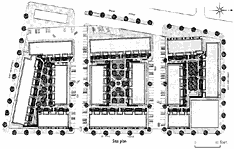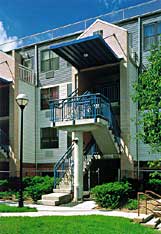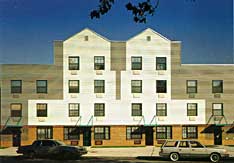 |
|
Project Summary: Melrose Court
OWNER/DEVELOPER
Procida Construction Corp.
ARCHITECT
Marvin H. Meltzer Architects, P.C.
CONSULTANTS:
Landscape Architect: Mark Morrison Assoc.
CONTRACTOR
The Procida Organization
PROPERTY MANAGEMENT
Classic Realty Corp.
| FUNDERS: | TYPE: |
| Chemical Community Development Corp. | Loan |
| N.Y. City Housing Partnership | Subsidy |
| Office of Bronx Boro. President | Subsidy |
| N.Y. City Hsg. Preservation and Devel. | Subsidy |
| Affordable Housing Corp., State of New York | Subsidy |
DEVELOPMENT TYPE:
New construction, for-sale stacked flats and townhouses.
RESIDENT PROFILE:
Low- and moderate-income families, incomes $22,000-53,000.
DENSITY: 60 units per acre
DEVELOPMENT PROFILE
| Type | #/Units | Size (sf) | Rents |
| 2 BR | 99 | 833 | $51,227 |
| 3 BR | 166 | 1,067 | $72,256 |
| Total | 265 | | |
Laundry: In each unit.
Courtyard/play: 3 courtyards, all secured.
Parking: 137, surface
Total site area 4.3 acres
|
CONSTRUCTION TYPE
Three- and four-story masonry bearing walls & concrete plank floors.
DEVELOPMENT COSTS:
Land costs $131,500; Constr. costs: $24,920,000; Other costs: $2,983,400; Total development
costs: $28,034,900 ($105,800/unit.); Completed Nov. 1993 (Phase I ), Nov. 1994 (Phase II).
|
|
|
MELROSE COURT, Bronx, New York
 Most people associate the South Bronx with crime, bombed-out buildings, and despair. This image is being transformed by the hard work and vision of architect Marvin H. Meltzer and Procida Organization (among many others) into one of resettlement, reinvestment, and hope. Melrose Court is the first mixed-income homeownership housing to be developed in the area of Melrose Commons. The Melrose Commons plan includes the revitalization of 200 square blocks with approximately 2,000 units of housing. Most people associate the South Bronx with crime, bombed-out buildings, and despair. This image is being transformed by the hard work and vision of architect Marvin H. Meltzer and Procida Organization (among many others) into one of resettlement, reinvestment, and hope. Melrose Court is the first mixed-income homeownership housing to be developed in the area of Melrose Commons. The Melrose Commons plan includes the revitalization of 200 square blocks with approximately 2,000 units of housing.
 Community input during the master-planning process generated guidelines that helped shape Melrose Court: three blocks of three- to four-story buildings surrounding secure courtyards at a density of 60 units per acre. Parking spaces located on demapped streets between the housing blocks are controlled by an owner-operated, locking metal bar secured to the pavement. The courtyards, which have become a focal point of activity for the residents, are friendly places to congregate with their stoops, colorful canopies, and attractive light fixtures. Community input during the master-planning process generated guidelines that helped shape Melrose Court: three blocks of three- to four-story buildings surrounding secure courtyards at a density of 60 units per acre. Parking spaces located on demapped streets between the housing blocks are controlled by an owner-operated, locking metal bar secured to the pavement. The courtyards, which have become a focal point of activity for the residents, are friendly places to congregate with their stoops, colorful canopies, and attractive light fixtures.
 Most apartments have individual entries from the courts; others are entered from the street. No entry is more than one-and-one-half flights up. The appearance from the courtyards is of individual townhouses. All apartments are two- and three-bedroom townhouses over flats with the bedrooms facing the street and the living rooms overlooking the courtyard for security. Most apartments have individual entries from the courts; others are entered from the street. No entry is more than one-and-one-half flights up. The appearance from the courtyards is of individual townhouses. All apartments are two- and three-bedroom townhouses over flats with the bedrooms facing the street and the living rooms overlooking the courtyard for security.
According to Marvin Meltzer the flat street facades are in deliberate contrast to the vibrant scale and texture of the courtyards. Some of the older character of the Bronx has been lost in recent years due to extensive demolition and it is very difficult, given today's budgets, to create a new character to match what has been lost. This is especially true when building for first-time homebuyers, since fewer funding sources are available to help subsidize homeownership as compared to rental housing. Creating interior courtyards provides a level of security and privacy not typical of the area. Resident Sarah Morales, a 37-year-old, working mother of two boys, who moved here from poorly managed public housing and feels much safer at Melrose Court, said, "The people here are all working people who have a stake in the community."
The fact that banks such as Chemical Bank and European American Bank have reconsidered their lending criteria to support reinvestment in this community is an inspiring example of new thinking in a traditionally conservative sector. The long term contribution that the entire Melrose Court development team has made to revive a community suffering from three decades of disinvestment has both physical and social rewards. The new families at Melrose Court have added almost 1,000 new people to a neighborhood known as a place to leave. The reduction in crime and blight is attracting still more community development.
|


